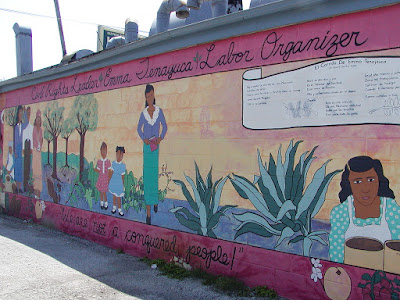Suburban DFW's Forgotten New Deal Colony Part 2
[You can find Part 1 here and I
fibbed there's a third part coming. Photos of DWG subsistence farmstead in both posts all courtesy of the Library of Congress.]
As we left off yesterday Dalworthington
Gardens, Texas looked to be on the ropes a bare year into its
founding as a New Deal planned farm community. But slowly and
stubbornly those 26 remaining families hung on and through their own
self-organization and tighter administration from New Deal entities
conditions start shifting from god-awful to livable.
 In 1935 the overstretched
administration of the program (it's running similar colonies of
varying scales all throughout the country such as this
beautifully-documented one outside Dayton, Ohio) is shifted to the
newly-created Resettlement Administration headed by the
magnificently-named Rexford G. Tugwell.
In 1935 the overstretched
administration of the program (it's running similar colonies of
varying scales all throughout the country such as this
beautifully-documented one outside Dayton, Ohio) is shifted to the
newly-created Resettlement Administration headed by the
magnificently-named Rexford G. Tugwell.
The shift in program
administration accidentally and narrowly saves both the national
program and Dalworthington Gardens as a few months later the Supreme
Court strikes down the NIRA in its entirety (that formerly
administered the program.)
“Rex the Red” as he is branded by
large Southern landowners is a frequent target for his “socialistic”
practices of trying to undercut the “labor supply”
(sharecroppers) of the tenant farm system. At any rate his vision is
even more sweeping, subsistence homestead colonies are to be not just back-to-the-land programs to better living conditions for urban workers but to
transform the American urban landscape from the top down: “My idea
is to go just outside centers of population, pick up cheap land,
build a whole community and entice people into it. Then go back into
the cities and tear down whole slums and make parks of them."
Subsistence homesteads nationally are
still relatively small affairs never more than 200 homes,
Resettlement Administration plans for large greenbelt cities begin
getting hothoused. Tugwell is supported by the left-populist then
Secretary of Agriculture, Henry Wallace (who would later famously go
on to be Vice President and then the 1948 presidential candidate for
the Progressive Party), himself trying to push through a number of
nationally-coordinated and planned farm production programs.
Despite Tugwell's drive and broader
vision the program is under pressure from within and without.
Conditions in Dalworthington Gardens though improving in 1935 are
still borderline squalid. Local residents change the name of one of
the three bisecting gravel roads from Eleanor Drive to Park Drive in
symbolic protest. Nationally the program is hitting all kinds of heat
from Congress for its skyrocketing costs
Finally in June 1936 Dalworthington is
removed from full administration from DC and given over to to the
locally run (but still federally-supervised) Dalworthington Homestead
Association with each family contributing a representative. The new
local association holds collective title to the all land, controls
the resident selection process, collects loan payments, and maintains
the community properties
With greater local autonomy the
struggling homestead seems to take off, thrive even. Guy Estil, a
local resident is elected to be settlement project manager and he
proves to be able and hands on. By early 1937, all but nine of the
over 50 abandoned homesteads are resettled and the community house
and park become a functional and actively used center of the
community. Fences are built, repairs kept up, school bus service
organized and gas lines laid.
Self-organization goes one interesting
step further too, in 1937 residents form Texas Industries, an
industrial cooperative. Run out of the community house, the coop
builds and sells butter churns, ladders, and household furniture.
But as Dalworthington's fortunes wax,
the national program quickly wanes. Under heavy fire from the Farm
Bureau and Dixiecrat allies Tugwell resigns and Congress passes a
provision in the Bankhead–Jones Farm Tenant Act that ends new
construction of subsistence homesteads (though 50 including
Dalworthington muddle on).
By 1942 with WW2 underway the federal
government is looking to consolidate and slim down its many varied
New Deal housing experiments and the Subsistence Housing Department
gets sloughed off with all the rest into the National Housing Agency.
Post-war, residents are ready to hang
it up and in 1949 they abolish the association and incorporate as a
town. The why is poorly documented but one can only guess that its
victim of that time and place when pre-war struggle and rising hope
for radical transformation slumps into the post-war order (which has
its seeds in the New Deal itself). But lets pick at some of that
thorny knot tomorrow.
[Tomorrow we wrap it up with a
broader look at the subsistence homestead experiment and the
contradictions of top-down reform in the New Deal against the then
rising tide of workers struggles. The Packinghouse Workers organizing
of the Fort Worth slaughterhouses and packing plants gets some love
alongside the Southern Tenant Farmers Union. Stay tuned.]






Comments
Post a Comment